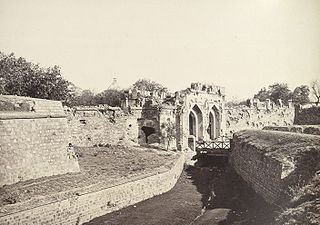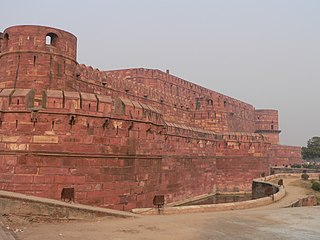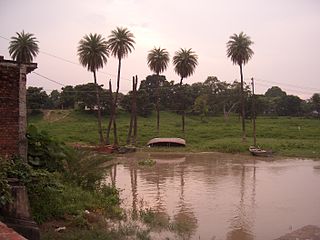Contents
| |||||
| Centuries: | |||||
|---|---|---|---|---|---|
| Decades: | |||||
| See also: | List of years in India Timeline of Indian history | ||||
Events in the year 1857 in India.
| |||||
| Centuries: | |||||
|---|---|---|---|---|---|
| Decades: | |||||
| See also: | List of years in India Timeline of Indian history | ||||
Events in the year 1857 in India.

The Indian Rebellion of 1857 was a major uprising in India in 1857–58 against the rule of the British East India Company, which functioned as a sovereign power on behalf of the British Crown. The rebellion began on 10 May 1857 in the form of a mutiny of sepoys of the company's army in the garrison town of Meerut, 40 mi (64 km) northeast of Delhi. It then erupted into other mutinies and civilian rebellions chiefly in the upper Gangetic plain and central India, though incidents of revolt also occurred farther north and east. The rebellion posed a military threat to British power in that region, and was contained only with the rebels' defeat in Gwalior on 20 June 1858. On 1 November 1858, the British granted amnesty to all rebels not involved in murder, though they did not declare the hostilities to have formally ended until 8 July 1859.

Nana Saheb Peshwa II, born as Dhondu Pant, was an Indian aristocrat and fighter, who led the rebellion in Cawnpore (Kanpur) during the 1857 rebellion against the East India Company. As the adopted son of the exiled Maratha Peshwa Baji Rao II, Nana Saheb believed that he was entitled to a pension from the company, but as he was denied recognition under Lord Dalhousie's doctrine of lapse, he initiated a rebellion. He forced the British garrison in Kanpur to surrender, then murdered the survivors, gaining control of the city for a few days. After a British force recaptured Kanpur, Nana Saheb disappeared, with multiple conflicting accounts existing of his further life and death.
The Battle of Aong took place on July 15, 1857, during the Indian rebellion of 1857, between the East India Company forces and Nana Sahib's forces.

The Siege of Lucknow was the prolonged defence of the British Residency within the city of Lucknow from rebel sepoys during the Indian Rebellion of 1857. After two successive relief attempts had reached the city, the defenders and civilians were evacuated from the Residency, which was then abandoned.

The siege of Cawnpore was a key episode in the Indian Rebellion of 1857. The besieged East India Company forces and civilians in Cawnpore were duped into a false assurance of a safe passage to Allahabad by the rebel forces under Nana Sahib. Their evacuation from Cawnpore thus turned into a massacre, and most of the men were killed and women and children taken to a nearby dwelling known as Bibi Ghar. As an East India Company rescue force from Allahabad approached Cawnpore, 120 British women and children captured by the rebels were butchered in what came to be known as the Bibi Ghar massacre, their remains then thrown down a nearby well. Following the recapture of Cawnpore and the discovery of the massacre, the angry Company forces engaged in widespread retaliation against captured rebel soldiers and local civilians. The murders greatly enraged the British rank-and-file against the sepoy rebels and inspired the war cry "Remember Cawnpore!".

During the Indian rebellion of 1857, general Bakht Khan served as a commander-in-chief in the region of the state Delhi of the Indian independent forces. He worked against the East India Company.

James George Smith Neill was a British military officer of the East India Company, who served during the Indian rebellion of 1857.

Farrukhabad district is a district of Uttar Pradesh state of India. The town of Fatehgarh is the district headquarters. The district is part of Kanpur Division.

The Siege of Delhi was one of the decisive conflicts of the Indian Rebellion of 1857. The rebellion against the authority of the East India Company was widespread through much of Northern India, but essentially it was sparked by the mass uprising by the sepoys of the Bengal Army, which the company had itself raised in its Bengal Presidency. Seeking a symbol around which to rally, the first sepoys to rebel sought to reinstate the power of the Mughal Empire, which had ruled much of the Indian subcontinent in the previous centuries. Lacking overall direction, many who subsequently rebelled also flocked to Delhi.

The Capture of Lucknow was a battle of Indian rebellion of 1857. The British recaptured the city of Lucknow which they had abandoned in the previous winter after the relief of a besieged garrison in the Residency, and destroyed the organised resistance by the rebels in the Kingdom of Awadh.
The Central India Campaign was one of the last series of actions in the Indian rebellion of 1857. The British Army and Bombay Army overcame a disunited collection of states in a single rapid campaign, although determined rebels continued a guerrilla campaign until the spring of 1859.

The Battle of Agra was a comparatively minor but nevertheless decisive action at the end of a prolonged siege during the Indian Rebellion of 1857.

Birjis Qadr was the son of Wajid Ali Shah, the last Nawab of Awadh. He was a put on the throne after his father had been deposed by the East India Company in 1856 under the terms of the Doctrine of lapse and Oudh State was annexed into the Bengal Presidency.

Satti Chaura Ghat or Massacre Ghat is a famous ghat in Kanpur, the industrial hub of Uttar Pradesh state in north India. It is located on the bank of the River Ganges in Kanpur Cantonment near Jajmau.
Edward Daniel Hamilton Vibart was a British military officer of the British East India Company, best known as a witness and chronicler of the Indian Rebellion of 1857, called by the British the "Sepoy Mutiny". At the time of the rebellion, Vibart was 19 years old, and a company commander in the 54th Bengal Native Infantry. Vibart's observations provide some of the best records of the violence committed by both sides during the rebellion.

The siege of Arrah took place during the Indian Mutiny. It was the eight-day defence of a fortified outbuilding, occupied by a combination of 18 civilians and 50 members of the Bengal Military Police Battalion, against 2,500 to 3,000 mutinying Bengal Native Infantry sepoys from three regiments and an estimated 8,000 men from irregular forces commanded by Kunwar Singh, the local zamindar or chieftain who controlled the Jagdishpur estate.

Martin Richard Gubbins (1812–1863) was a British official in India. He is known for his part in the Siege of Lucknow, where he was at odds with the commanding officer, Henry Montgomery Lawrence.
Barkat Ahmad was a sepoy mutineer and leading figure of the Indian Rebellion of 1857. Barkat Ahmad led the army of Indian rebels in the Battle of Chinhat, in Awadh region. Barkat Ahmad was a highly trained British sepoy. He led the rebels against the British officer Sir Henry Lawrence who was then located at the Residency.
Joseph Rooney was an Irish missionary priest who was instrumental in the founding of a number of educational institutions in India during the period of the Company rule in India. He was killed in a massacre in the Siege of Cawnpore in India, a key episode in the Indian Rebellion of 1857.
Sir John Blick Spurgin (1821–1903) was a British army officer, a prominent figure of the Indian Rebellion of 1857.